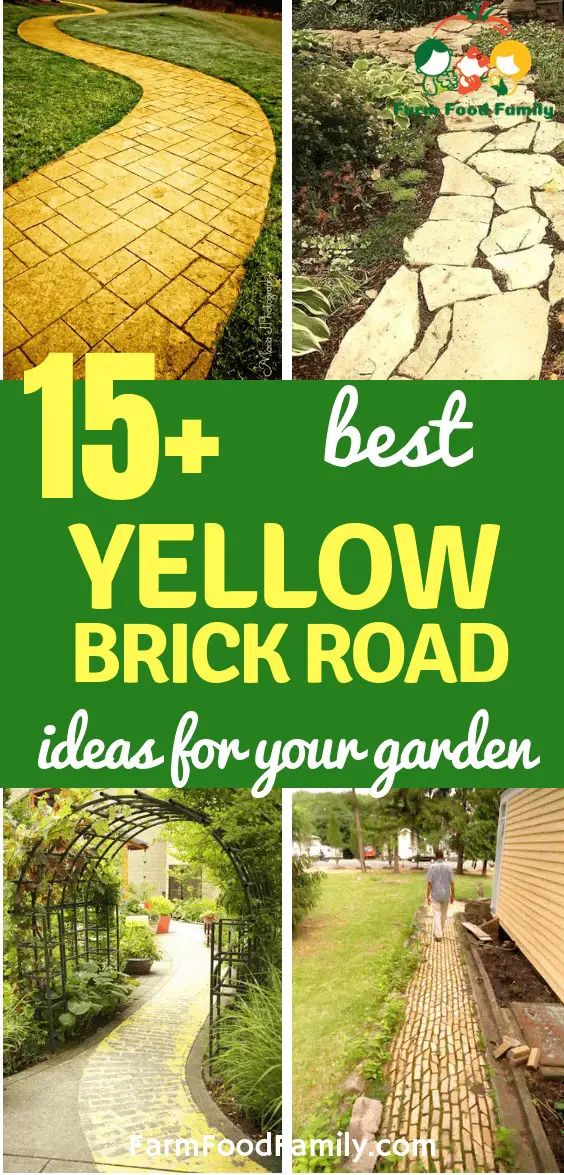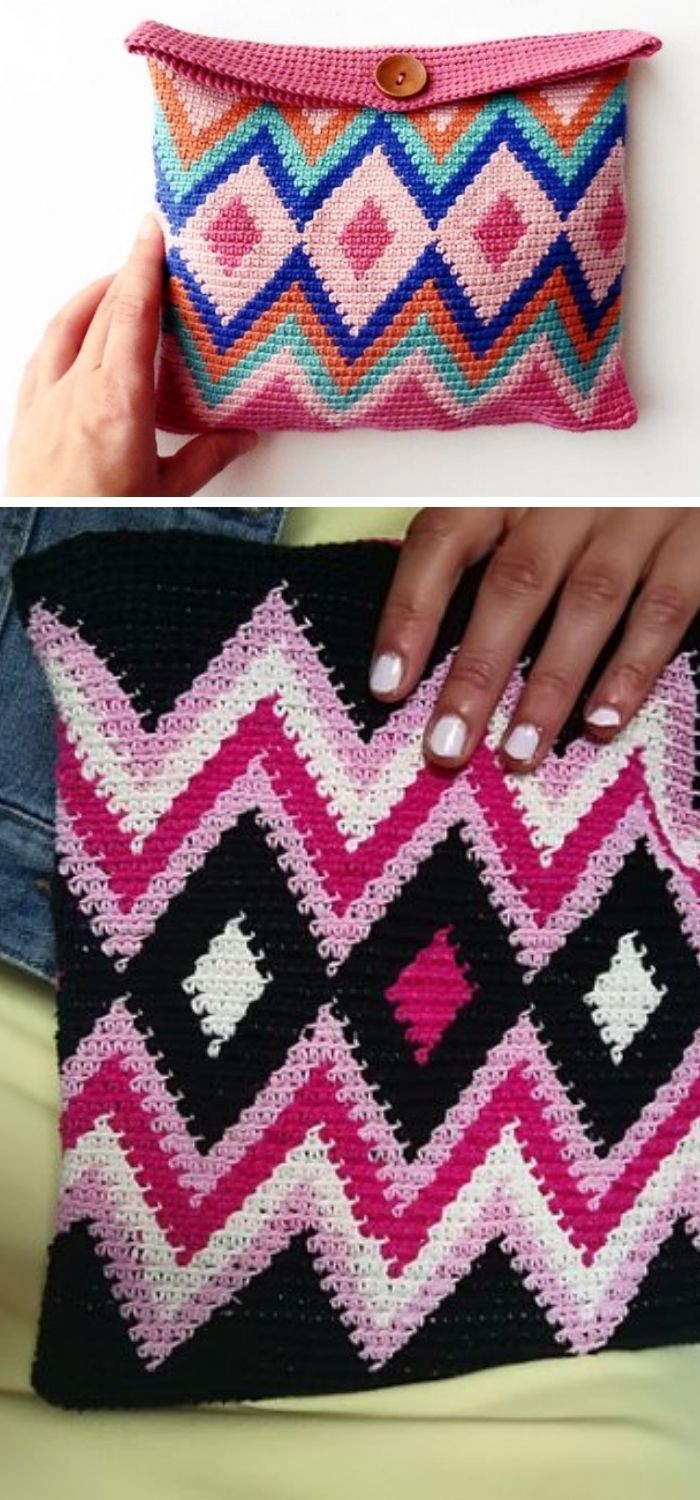18 Diy Doll Head Planter Ideas And Projects In 2024
Are you ready to shake things up and add a touch of whimsy to your home or garden decor? Look no further than DIY doll head planters. This unique approach not only gives old dolls new life but also allows you to showcase your plants in a truly one-of-a-kind way. As an added bonus, these planters can be conversation starters, bringing a quirky charm to any space. The best part? You get to craft them yourself, making each piece truly personalized and reflecting your individual style.
Whether you’re a seasoned DIY enthusiast or just starting out, this project offers a fun and creative outlet with practical benefits – turning potential trash into treasure. With a little imagination and some basic crafting skills, you can transform old dolls into beautiful garden decorations, adding a touch of elegance to any outdoor space. And the best part? You can customize each planter to fit your personal style, making it a truly unique piece that reflects your individual taste.
Inspiration for DIY Doll Head Planters
The Origins of Using Doll Parts for Artistic Purposes
Artistic expression has long been rooted in the creative reimagining of discarded materials, with doll parts – particularly heads – serving as a canvas for artistic exploration. This unconventional medium has allowed artists to push boundaries, convey messages, and redefine traditional notions of art and beauty. More recently, the trend of transforming doll heads into planters has emerged, marrying gardening enthusiasts’ passion with artistic innovation.
This innovative blend not only showcases an aesthetically pleasing outcome but also celebrates sustainability by repurposing materials that would otherwise contribute to waste accumulation.
How Artists and DIY Enthusiasts Have Transformed Doll Heads into Planters
Across the globe, artists and DIY enthusiasts have taken to transforming doll heads into planters, showcasing a remarkable array of creativity and ingenuity. What was once a seemingly ordinary object has been reborn as a unique vessel for nurturing life. From humble succulent holders to intricate floral arrangements, each creation serves as a testament to the power of transformation and the human ability to reimagine the ordinary.
The sheer diversity of these planters – be it Jane Doe’s simple yet elegant succulent holder or John Smith’s gothic-inspired arrangement – is a true reflection of the creator’s imagination and potential.
The Variety of Looks That Can Be Achieved (Vintage, Modern, Gothic, etc.)
What makes DIY doll head planters so captivating is their adaptability. The diverse array of doll heads available, combined with the numerous types of plants that can be used, allows for an incredible range of styles and aesthetics. From vintage-inspired pairings featuring delicate flowers or ferns to modern and minimalist combinations showcasing succulents or air plants, the possibilities are endless.
In addition to these two extremes, there’s also a darker, more dramatic side to doll head planters. Pairing dolls with exotic plants or bold red flowers can evoke a gothic ambiance that’s sure to captivate fans of the mysterious and unknown. This versatility ensures that there’s a DIY planter style to suit every taste and decor theme, making them a popular choice among individuals from all walks of life.
Whether placed in a cozy corner of a home or as a statement piece in a garden, these planters bring personality and charm to any space.
Advantages of Crafting Doll Head Planters
Positive Environmental Contribution through Upcycling
Transforming discarded dolls into functional planters is an innovative approach to reducing waste. By giving old dolls a new purpose, we can extend their lifespan and prevent them from contributing to landfill growth. This creative endeavour not only reduces the environmental impact of our actions but also fosters a culture of reusing and upcycling.
As we strive for sustainability, repurposing what’s considered ‘trash’ into treasured decor is an important step towards making more eco-friendly choices.
Personalized Decor Reflecting Individual Taste
The true allure of DIY doll head planters lies in their ability to reflect one’s distinct character. This creative endeavour transcends mere plant housing, instead allowing for a deeply personal expression. Every choice, from selecting the perfect doll to pairing it with the ideal plant, serves as an opportunity to imbue the planter with a piece of your personality.
As such, these handmade creations become one-of-a-kind masterpieces, distinguished from mass-produced alternatives by their inherent uniqueness and flair.
Affordability and Accessibility
Embarking on a doll head planter project offers a unique opportunity for creativity and frugality. Unlike more traditional DIY endeavors, this initiative requires only basic materials, including the doll heads themselves and simple gardening supplies. This accessibility is a significant advantage, as it means that anyone can participate in this creative pursuit without breaking the bank.
In fact, the affordability of the necessary materials makes it an attractive option for those on a budget or simply looking to add some personality to their space without incurring excessive expenses.
Choosing the Right Doll Heads
Selecting Suitable Doll Heads for Conversion
Not all dolls are ideal candidates for transforming their heads into planters. The material, size, and shape of the doll head play a significant role in determining the success of your project. To produce a beautiful planter, you should focus on finding a doll head made from durable materials that can withstand exposure to soil moisture and sunlight if it’s intended for outdoor use. Plastic and ceramic are excellent options due to their resilience. The size of the doll head is also crucial.
A head that’s too small might not provide sufficient space for your plant, while one that’s excessively large could require more space than you have available. The shape of the doll head should harmonize with the type of plant you intend to house, leaving enough room for growth and easy watering.
Ideas for Sourcing Doll Heads
Embarking on a quest for doll heads can be an exciting journey. Thrift stores and yard sales offer treasure troves of vintage dolls at affordable prices, not only supporting recycling and sustainability but also potentially leading to discovering unique characters with their own stories. You can also breathe new life into broken toys from your own home or a friend’s, giving them a second chance at being loved.
Moreover, online marketplaces and community exchange groups can be valuable resources for finding dolls, often with individuals willing to part with items for free or at a minimal cost. By exploring these avenues, you not only acquire the necessary materials but also contribute to reducing waste, aligning with the eco-friendly ethos of this project.
Materials and Tools Needed
To begin crafting unique doll head planters, it’s essential to gather all the necessary materials and tools upfront. This ensures a smooth creative process from start to finish. To help you get started, here’s a detailed rundown of what you’ll need:
Required Supplies
At the heart of your miniature garden project lies the doll head, which serves as the focal point. To create a visually appealing arrangement, carefully select a doll head that aligns with your desired aesthetic. Next, choose small plants or succulents that harmonize with the size and shape of your doll head. The trio’s foundation is established by a well-suited potting mix designed for the specific plant species. A crucial consideration is drainage materials to prevent waterlogged soil.
Small stones or pebbles can effectively facilitate water flow while minimizing mess. Finally, ensure you have the necessary cutting tools at hand, including sharp scissors, knives, and possibly a drill, to create the planting space and carefully drilled drainage holes.
Additional Materials
When it comes to outfitting your doll-based planter, don’t forget about the importance of protective gear. Gloves are a must-have when handling sharp tools and potentially toxic materials that may be used in the customization process. Additionally, paints and brushes can be used to further personalize the doll heads, giving you endless opportunities for creativity.
To ensure the longevity of your planter, consider applying a sealant to waterproof internal surfaces – especially crucial for non-plastic dolls. Finally, decorative elements such as beads, fabric, or waterproof markers provide a unique touch, allowing you to put your own personal stamp on the project.
Safety Considerations and Protective Gear Recommendations
When tackling DIY projects, it’s crucial to prioritize safety. With sharp tools and potentially hazardous materials involved, it’s essential to take precautions to protect yourself. To ensure a smooth, safe, and enjoyable experience, consider the following recommendations: Wear sturdy gloves to shield your hands from sharp edges and materials, and invest in safety goggles when drilling or cutting to prevent debris from entering your eyes.
If you’re working with potentially toxic materials or sanding painted surfaces, don’t forget to wear a dust mask to prevent inhalation of harmful particles. Finally, make sure you’re working in a well-ventilated area, especially if using sealants or paints. By taking the time to prepare and having all necessary materials and safety gear at your disposal, you’ll be able to complete your project with confidence and peace of mind.
Step-by-Step Guide to Making Doll Head Planters
Transforming a doll head into a one-of-a-kind planter is a delightful fusion of creativity and horticulture. To bring this innovative idea to life, follow the meticulous steps outlined below, as you breathe new life into an otherwise ordinary toy head, crafting a distinctive vessel for your plants.
Preparing the Doll Head
To revitalize your doll planter, start by giving the doll head a thorough cleaning. Soak it in soapy water and gently scrub away any dirt, dust, or residue that may be hiding in its crevices. Rinse it thoroughly and let it air dry completely before proceeding. Next, assess whether there are any unnecessary parts attached to the doll that won’t serve a purpose in your planter – such as hair or electronics. Take this opportunity to remove them if necessary.
Finally, use a drill or a sharp tool to create one or more drainage holes at the bottom of the doll head. This is crucial for maintaining healthy plants, as it allows excess water to escape and prevents root rot.
Choosing and Planting Suitable Plants
When selecting plants for your miniature garden, prioritize species that complement the size of your doll head and align with your care capabilities. Succulents, small flowers, and herbs are excellent options due to their compact nature and ability to thrive in a variety of conditions. Before planting, carefully remove your chosen flora from its current potting medium, gently shaking off any excess soil and inspecting the root system.
Trim any roots that have grown excessively long to promote healthy growth. To prepare the doll head for planting, start by adding a layer of drainage material at the base. Fill approximately half of the container with potting soil, then position your plant inside, leaving enough space to add more soil around its base until it’s securely anchored. Finally, gently press on the soil to eliminate any air pockets and ensure a sturdy foundation for your miniature garden.
Decorating Your Doll Head Planter
To give your doll head planter an extra pop of personality, consider adding some creative touches before planting. If you’re feeling artistic, use paints suitable for the doll’s material to add a splash of color, and don’t forget to seal it if your new planter will be spending time outdoors. Once you’ve got your painting skills on point, it’s time to think about accessories. Miniature hats, glasses, or jewelry can add a whimsical touch and really let your creativity shine.
As for placement, take the time to consider the plant’s light and water needs when choosing a spot. Find a location that will provide the perfect conditions for your new greenery to thrive.
Final Touches
To ensure the health and well-being of your plants, start by providing gentle water after planting. Be cautious when watering in doll heads without extensive drainage systems, as overwatering can be detrimental. Moving forward, place your planter in an area that receives the ideal amount of sunlight for the specific plant variety you’ve selected. Regularly monitor soil moisture and adjust your watering schedule accordingly to keep your plants thriving.
By following these simple steps, you’ll not only create a stunning doll head planter but also add a touch of personality to your décor. Whether displayed indoors or outdoors, these unique planters are sure to spark conversations and bring a whimsical flair to your space.
Decorating and Placement Ideas for Doll Head Planters
Doll head planters bring a dash of imagination and originality to any space, effortlessly blending into various decorative styles. To incorporate these charming containers into your abode and outdoor areas, consider the following tips, as well as ideas for adapting them to different seasons and holidays.
Integrating into Various Decor Styles
To create unique and captivating spaces, consider incorporating doll head planters into your home decor. For a bohemian-inspired look, combine the planter with eclectic textiles and mixed patterns. Adding succulents or trailing plants like ivy can enhance the overall aesthetic. In contrast, a modern minimalist approach involves pairing sleek doll head designs with simple, sculptural plants on a stark white shelf. This creates a striking focal point in a clean-lined setting.
For a vintage-inspired look, choose antique or vintage-style doll heads and pair them with classic flowers. Place them on distressed wood furniture or alongside vintage books for a nostalgic feel. Finally, for a gothic-themed space, opt for doll heads with darker features or paint them in deep colors. Pair these with dark-leaved plants and place them in a dimly lit corner to create a dramatic and mysterious ambiance.
Ideas for Indoor and Outdoor Placement
When it comes to showcasing your doll head planters, you have a variety of options both indoors and outdoors. For a touch of greenery in your workspace or kitchen, consider placing them on window sills, bookshelves, or desks. Alternatively, bring the outdoors in by incorporating them into your garden among the foliage, or add a whimsical touch to patio tables or even tree branches with secure fixtures.
Whichever spot you choose, doll head planters are sure to add an unexpected element of surprise and charm to your surroundings.
Seasonal Decorating Tips
Spring brings new life, so adorn your doll head planter with fresh flowers like daisies or tulips, accompanied by pastel ribbons or Easter eggs that evoke a sense of renewal. Summer’s warmth is reflected in vibrant blooms or succulents, while adding miniature sunglasses or a tiny sunhat gives the planter a playful personality. As autumn arrives, use plants with fall colors like orange marigolds or red coleus, surrounded by small pumpkins or faux leaves to create a cozy atmosphere.
In winter, evergreen plants or frost-resistant varieties thrive, complemented by miniature holiday ornaments or a tiny scarf that exudes warmth and festivity. Ultimately, doll head planters are a delightful way to add whimsy and personality to your space, regardless of the season or decor style.
Upcycled Dolls Heads
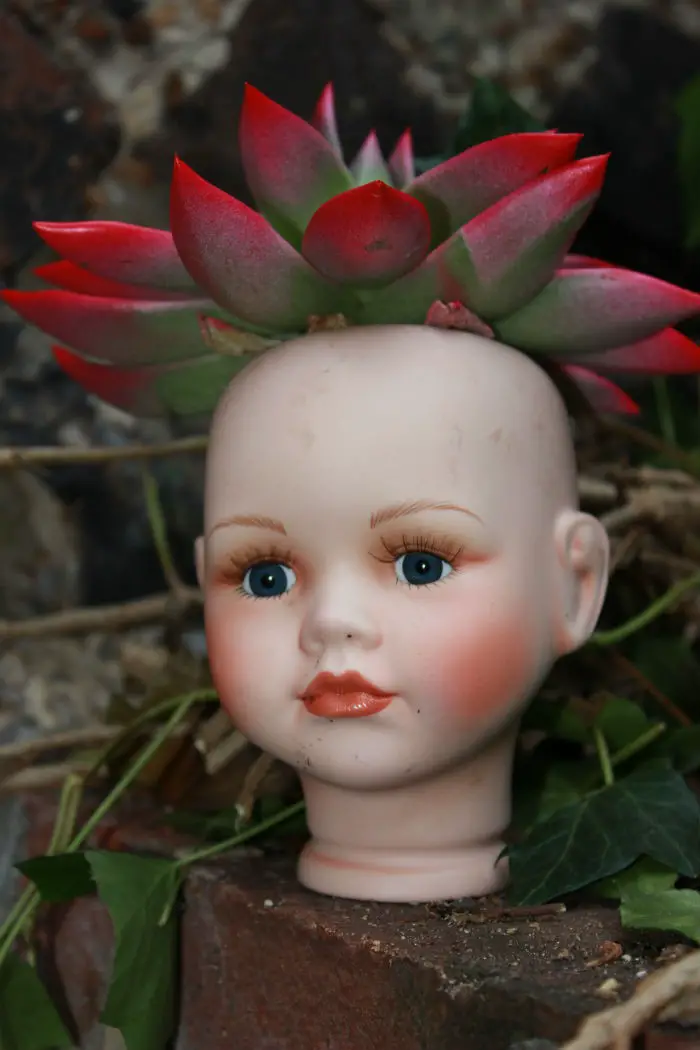
Faux Copper Head Planter
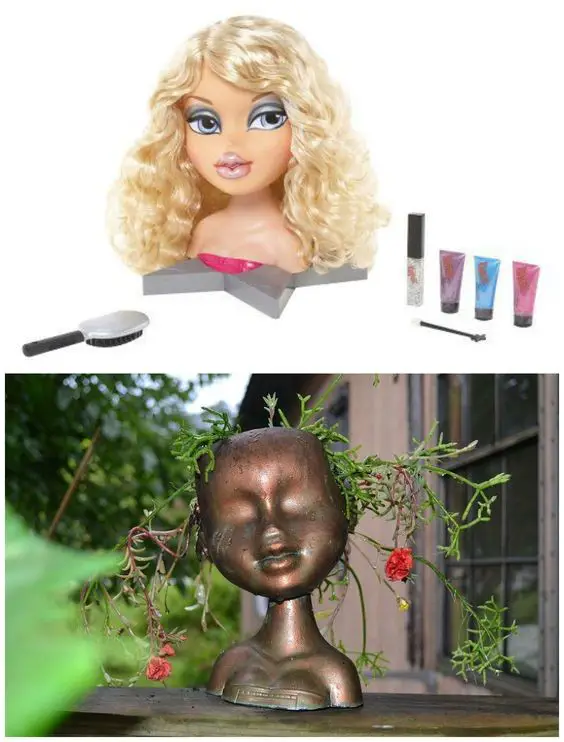
To transform an ordinary planter into a charming faux copper head planter, you’ll need to employ various artistic techniques and follow a multi-step process that yields an authentic aged copper appearance. The journey begins with…
Preparation and Painting
To bring your doll-making project to life, you’ll first need to prepare the foundation. Begin by carefully selecting a suitable doll head and giving it a thorough cleaning to ensure any dirt or debris won’t interfere with paint adhesion. This step is crucial for achieving a smooth, even finish. Next, apply a spray primer specifically designed for the doll head’s material (plastic or ceramic). This primer will create a uniform base for your painting, ensuring colors pop and details stand out.
Finally, it’s time to add some shine! Use copper metallic spray paint to give your doll head a rich, shiny finish that resembles a warm, burnished metal. As you apply each layer, take note of how the different textures and hues come together to create a truly unique piece.
Creating the Patina Effect
For a truly unique and aged appearance, consider combining copper paint with patina effects. A light misting of green or blue patina paint can create a distressed, weathered look that evokes the sense of years spent outdoors. This subtle yet striking effect will give your planter an air of authenticity, as if it had been seasoned by the elements over time.
Plant Selection and Placement
When it comes to selecting plants for a doll’s head, succulents and small, hardy species are ideal choices due to their low maintenance requirements and ability to thrive in compact spaces. To ensure the best results, begin by preparing the planting area with a suitable potting mix or soil that meets the specific needs of your chosen greenery. Next, carefully place your plant into the prepared head, taking care not to damage any delicate roots or stems.
With a little patience and attention, you’ll be rewarded with a beautiful and unique miniature garden that showcases your creativity and skill.
Turn Old Dolls Into Beautiful Garden Decorations
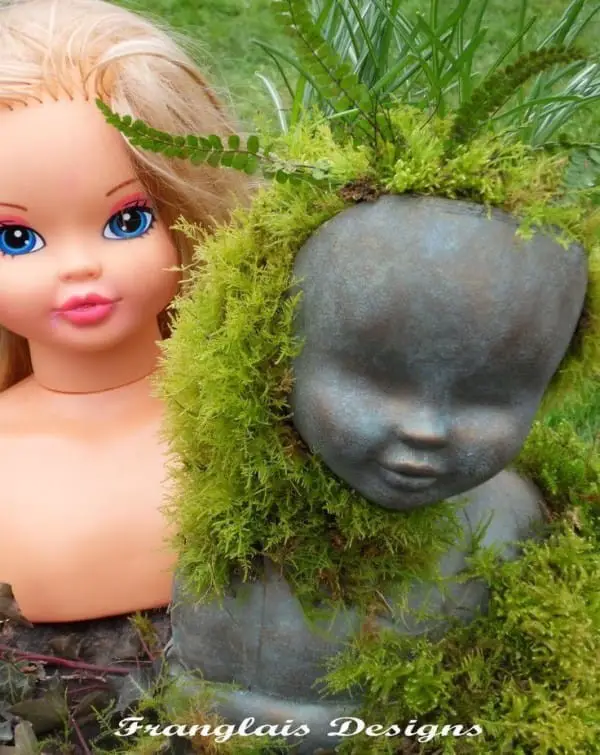
A Plantroll Is A Troll Doll With An Air Plant For Hair

By fusing the retro allure of troll dolls with the natural charm of air plants, the Plantroll concept brings forth a captivating fusion. The iconic spiky hair of the doll is cleverly replaced by a lush, green display, courtesy of an attached air plant. This innovative creation capitalizes on the low-maintenance and soil-free nature of air plants, which thrive in air, light, and occasional watering.
As such, this unique combination not only breathes new life into a nostalgic toy but also offers a playful and vibrant way to bring more greenery into your space. Plantrolls can be enjoyed as charming desk companions, quirky decor pieces, or creative gifts, effortlessly infusing any environment with whimsy and freshness.
Mannequin Garden head Meet Betty Bling and Butch
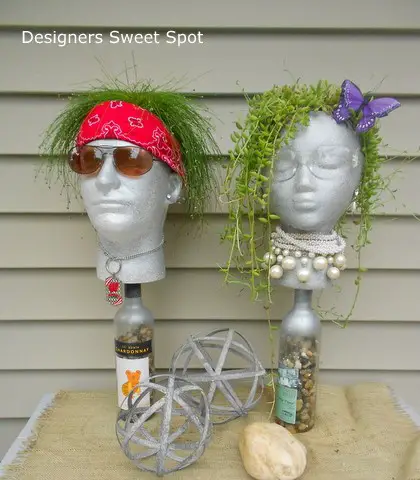
Carnivorous sundew plants in a doll head planter
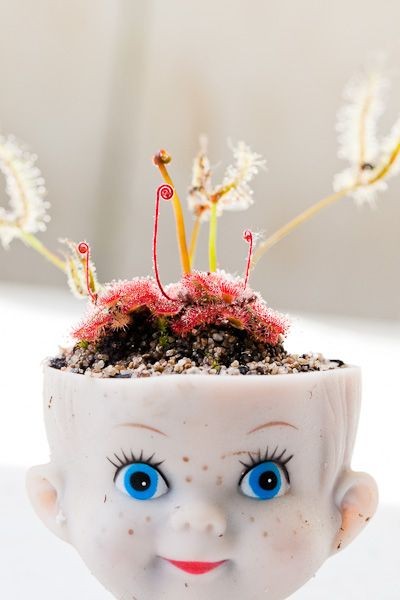
Within a doll head planter, carnivorous sundews take on an unsettling yet captivating quality. Their sticky tendrils, typically used to trap insects, become a mesmerizing, moving feature atop the doll’s head. This unconventional display not only showcases these fascinating plants but also sparks conversation by combining the natural with the eerie.
The glistening leaves emerging from the doll’s scalp can be both beautiful and unnerving, making it an ideal choice for those seeking to add an offbeat yet captivating element to their home or garden decor. By merging botanical curiosity with creative planter design, the doll head planter adds a human touch to the predatory elegance of the sundew, blurring the lines between nature and art.
Dolls heads planters
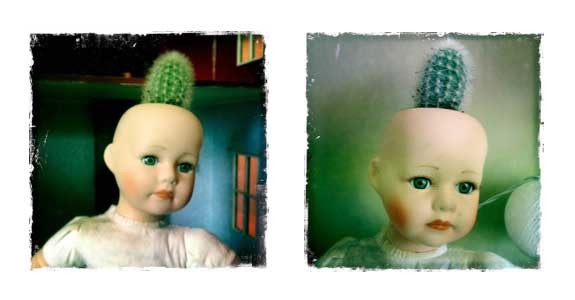
Troll Doll Planter DIY
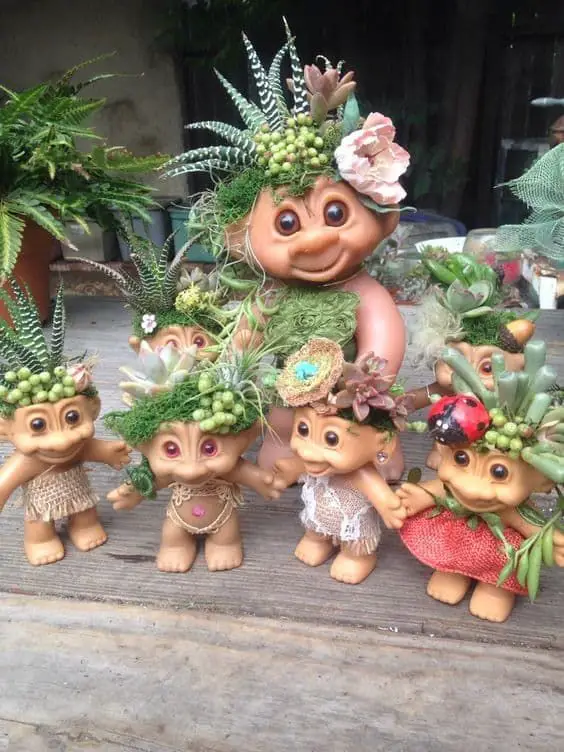
Faux Rusty Cast Iron Head Planter

Transforming a ordinary planter into a faux rustic cast iron head planter is an innovative way to infuse your outdoor or indoor space with a hint of vintage elegance. By imbuing a new or existing vessel with the patina of aged, rusty cast iron, you can create a unique decorative piece that exudes warmth and character. Here’s a step-by-step guide to help you achieve this distinctive look:
Materials Needed:
To bring your DIY graveyard decoration to life, you’ll need some essential materials. Start by sourcing a head-shaped planter made from lightweight materials such as plastic or resin. This will provide a sturdy base without being too heavy or cumbersome. Next, gather black and dark brown spray paint to create the illusion of cast iron. For the rust effect, acquire orange, red, and brown acrylic paints that can be easily blended together to achieve a weathered look.
Don’t forget to grab some basic painting tools like paintbrushes, sponges, and potentially even a sea sponge for added texture. Finally, make sure you have a clear sealant on hand to protect your finished masterpiece from the elements.
Steps to Create a Faux Rusty Cast Iron Look:
To give your planter a vintage look, start by thoroughly cleaning it to ensure the paint adheres well. Next, apply a base coat of black or dark brown paint to mimic cast iron, allowing it to dry completely before moving on. For the rust effect, employ a dry brush technique to layer orange, red, and brown acrylic paints in areas where corrosion would naturally occur – such as crevices and raised details. A sea sponge can be used to add texture.
To achieve a more realistic rust appearance, apply small, concentrated spots of rust color to specific areas using a sponge or stiff brush. Once the rust effect is complete and dry, seal your planter with a clear coat to protect it from the elements, especially if it will be used outdoors. With this project, you have the freedom to adjust the level of ‘rust’ to suit your desired level of antique charm.
Styrofoam Heads Garden Pots
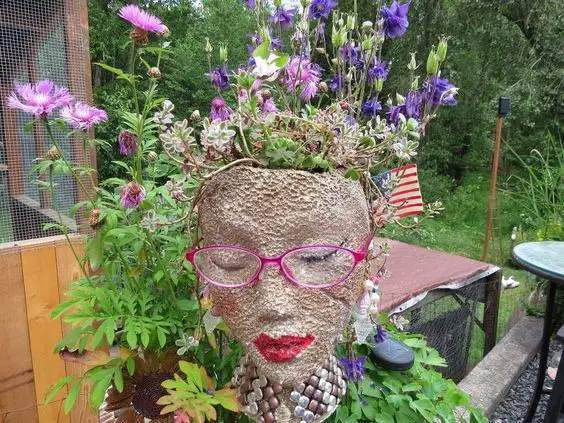
With its versatility and creative possibilities, using Styrofoam heads as garden pots is an innovative way to showcase plants. This unconventional approach can bring a dash of personality and avant-garde flair to any outdoor or indoor setting. The lightweight and movable nature of these Styrofoam planters makes it easy to experiment with different arrangements, while the surface provides a unique canvas for artistic expression.
Sneaker Love
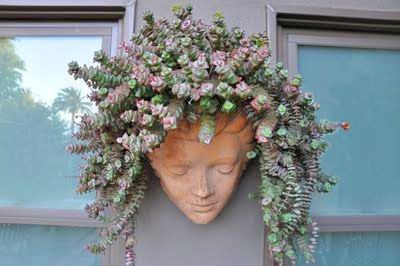
Head planter
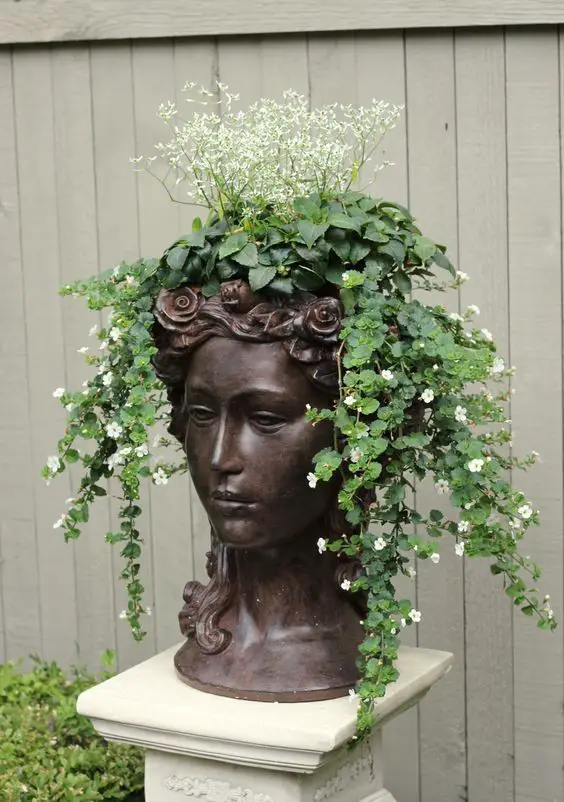
Scalping doll heads
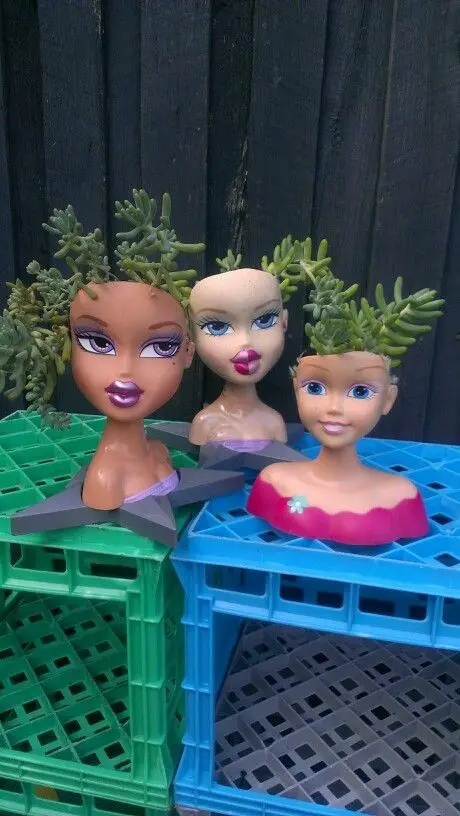
Repurposed Planter
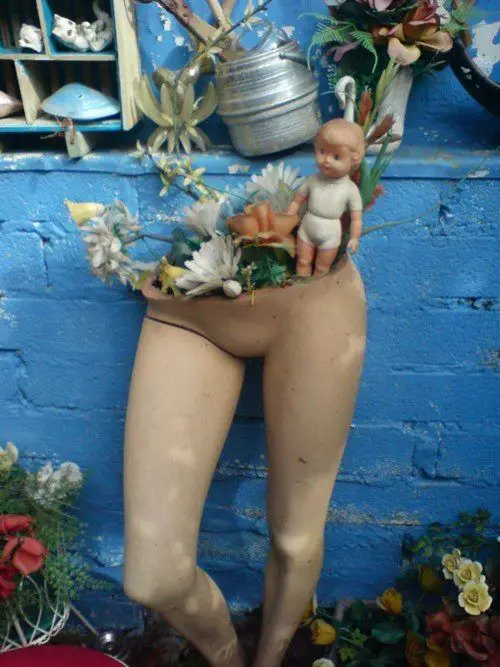
Doll head planters

Garden head for succulents
Troll doll planters
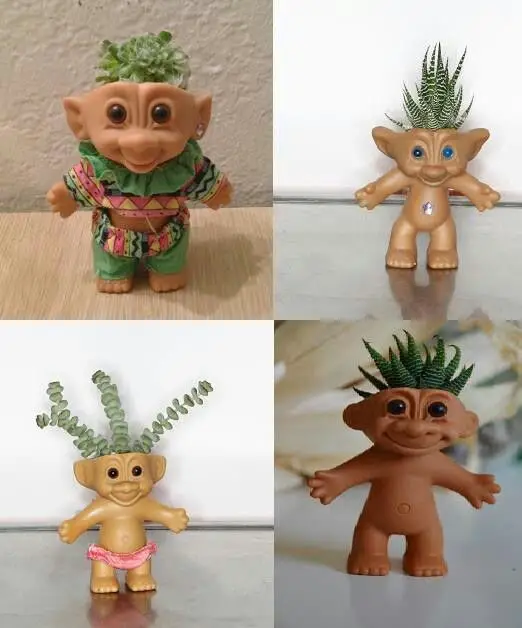
DOLL HEADS + SUCCULENT PLANTS

Embracing unconventional creativity, utilizing doll heads as planters for succulent plants offers a fascinating and thought-provoking way to elevate home and garden decor. The juxtaposition between the tender, organic essence of succulents and the rigid, human-like features of doll heads yields a captivating visual experience that can oscillate from whimsically playful to intriguingly unsettling.
Care and Maintenance for Doll Head Planters
For optimal results, regular maintenance is essential when it comes to doll head planters and their resident foliage. To prolong the lifespan of your planter and keep your plant thriving, follow these key guidelines. By doing so, you’ll not only preserve the integrity of the ceramic or porcelain vessel but also promote healthy growth for the botanical beauty within.
Caring for Plants in Doll Head Planters
When it comes to caring for your plants in doll head planters, remember that every species has unique needs. Start by getting the watering just right – since these planters can be prone to waterlogging, it’s crucial to avoid overwatering. Use a spray bottle or water slowly and directly at the soil level to ensure the roots don’t rot. Next, consider the sunlight requirements of your plants.
Some species love basking in bright, indirect light, so place them near a sunny windowsill or spot with plenty of ambient illumination. On the other hand, plants that prefer shadier conditions will do better in cooler, less exposed areas of your home. Just be sure to keep an eye out for any signs of insufficient lighting, as this can impact their overall health. Finally, don’t forget about soil quality! Different types of plants have distinct preferences when it comes to the ground they grow in.
Succulents and cacti tend to thrive in sandy, well-draining mixes, while other houseplants might do better with a more moisture-retentive soil. As an added bonus, refreshing your plant’s soil annually can provide a boost of fresh nutrients and encourage healthy growth.
Maintaining the Doll Head Planter
To maintain the appearance and longevity of your unique doll head planter, regular cleaning is essential. Begin by gently wiping down the surface with a damp cloth to remove any accumulated dust or dirt. For more thorough cleanings, a mild soap and water solution can be used, ensuring that the planter is completely dry before replanting. This simple step will help prevent soil from getting soggy and reduce the risk of root rot.
Over time, the paint on your planter may fade due to exposure to sunlight or the elements. To revive its original color, use suitable paints for repainting purposes, applying a sealant if the planter is intended for outdoor use. This will not only protect the paint but also shield the material from damage caused by weathering. Finally, conduct regular inspections of your doll head planter to detect any signs of cracking or damage, especially if it’s made from a fragile material like ceramic.
Identifying and addressing these issues promptly will help preserve the structural integrity of the planter, allowing it to continue serving as a charming home for your plants.
Additional Tips
As plants grow and thrive, they’re sensitive to changes in their environment. To ensure your doll head planter’s occupant stays healthy and happy, be aware of seasonal adjustments that may impact your plant’s needs. As the seasons change, adjust the placement of your planter to provide optimal light and warmth conditions. This simple step can make all the difference in promoting a strong and resilient plant.
It’s also crucial to stay vigilant for signs of pests and deal with any infestations promptly to prevent damage to both your plant and planter. By being mindful of these factors, you’ll be able to appreciate the unique charm of your doll head planter for years to come while keeping your plant in top condition.
Troubleshooting Common Issues with Doll Head Planters
While doll head planters’ whimsical charm is undeniable, they do come with their own set of challenges. To overcome these hurdles, let’s explore some practical solutions for issues like inadequate drainage, plant overgrowth, and even damage to the planter itself.
Inadequate Drainage
When it comes to planters, one common issue many gardeners face is water pooling at the bottom. This can lead to root rot and ultimately, unhealthy plants. To prevent this from happening, there are a few simple solutions you can try. First, make sure your planter has adequate drainage holes at the bottom. If that’s not possible or practical, consider adding a layer of pebbles or charcoal to the base of the planter before filling it with soil.
These materials will help absorb excess water and prevent pooling. Additionally, using a high-quality soil mix that is designed to promote good drainage can also go a long way in keeping your plants happy and healthy.
Plant Overgrowth
When using doll head planters, one common issue that arises is the rapid growth of the plant outpacing the container’s capacity. As a result, the roots become cramped and the overall plant growth is stunted. To mitigate this problem, it’s essential to regularly monitor your plant’s size and root development. If you notice the plant becoming too large for its home, don’t hesitate to transplant it into a larger planter.
Furthermore, opting for slow-growing or compact varieties of plants specifically designed for doll head containers can help minimize the need for frequent repotting.
Damage to the Doll Head
Cracks, fading, or other forms of damage can significantly impair the aesthetic appeal and functional integrity of a doll head. To effectively mitigate these issues, it’s essential to employ targeted solutions.
In cases where cracks or breaks have occurred, a suitable adhesive specifically designed for the material of the doll head (plastic, ceramic, etc.) should be used to repair the damage.
Conversely, if the exterior is experiencing fading or peeling, a coat of outdoor-grade paint and sealant can restore its original appearance while providing protection against weathering and sunlight exposure.
Proactive maintenance checks are also crucial in detecting potential damage at an early stage, enabling swift and effective intervention to prevent more severe issues from developing.
Additional Tips for Common Issues
When it comes to maintaining healthy plants in doll head planters, two common issues to watch out for are algae or mold growth and pests or diseases. Algae or mold forming on the soil or inside the planter is often a result of excessive moisture and poor air circulation. To address this, ensure the planter is placed in a well-ventilated area and adjust your watering habits accordingly.
If the issue persists, removing the affected soil and replacing it with fresh, sterile potting mix can help eradicate the problem. Similarly, keep an eye out for signs of pests or disease in your plant, such as unusual growth patterns or discoloration. Isolating the affected planter and treating the plant with organic or chemical treatments as needed can prevent the issue from spreading to other plants.
By staying vigilant and attentive to the needs of both your plant and doll head planter, you’ll be able to enjoy the unique charm and conversation-starting appeal of these planters while minimizing common issues.
Conclusion
As we conclude our exploration of DIY doll head planters, it’s clear that this creative endeavor transcends mere crafting – it’s an invitation to tap into your artistic soul and connect with nature on a deeper level. By reimagining discarded dolls as botanical masterpieces, you’re not only adding a touch of whimsy to your space but also contributing to a more sustainable world where artistry meets eco-friendliness.
As you reflect on the journey we’ve taken together, remember that the true magic lies not just in the final product, but in the process itself. The freedom to experiment with different doll heads, plants, and decorating techniques is what makes DIY so thrilling.
Whether you’re drawn to the playfulness of succulents spilling out of vintage dolls or the haunting allure of carnivorous plants nestled within ceramic crania, each planter you create is a testament to your imagination and creative spirit. As you set out to craft your own unique planters, keep in mind that the beauty of DIY lies not just in the end result but in the moments of discovery, experimentation, and growth that unfold along the way.
So gather your materials, tap into your creativity, and transform the ordinary into something extraordinary. The possibilities are endless, limited only by your imagination.


